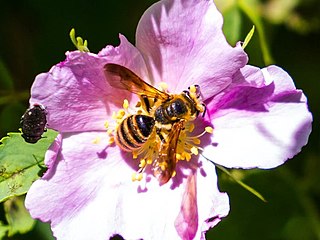Centris cockerelli is a species in the family Apidae, in the order Hymenoptera . The distribution range of Centris cockerelli includes Central America and North America.

Hoplitis anthocopoides is a species in the family Megachilidae, in the order Hymenoptera . The distribution range of Hoplitis anthocopoides includes Africa, Europe, Northern Asia, and North America.

Colletes simulans is a species in the family Colletidae, in the order Hymenoptera. The species is known generally as the spine-shouldered cellophane bee. It is found in North America.
Crabro villosus is a species in the order Hymenoptera, in the class Insecta ("insects"). It is found in North America.

Andrena krigiana is a species in the family Andrenidae, in the order Hymenoptera. The species is known generally as the "dwarf-dandelion andrena". It is found in North America.
Stictiella formosa is a species in the order Hymenoptera, in the class Insecta ("insects"). The distribution range of Stictiella formosa includes Central America and North America.
Andrena palpalis is a species of mining bees in the family Andrenidae. It is found in Central America and North America.

Calliopsini is a tribe of mining bees in the family Andrenidae. There are at least 120 described species in Calliopsini.
Triepeolus rufithorax is a species of cuckoo bee in the family Apidae. It is found in North America.
Andrena perarmata, the armed miner bee, is a species of miner bee in the family Andrenidae. Another common name for this species is the well-armed andrena. It is found in North America.

Dufourea monardae, the monarda dufourea, is a species of sweat bee in the family Halictidae. It is found in North America. It is an oligolectic bee on bee balm plants.

The cherry leaf miner bee is a species of miner bee in the family Andrenidae. Another common name for this species is cherry plum miner. It is found in Central America and North America.
The lonely miner bee is a species of miner bee in the family Andrenidae. It is found in Central America and North America.

The golden-haired miner bee is a species of miner bee in the family Andrenidae. The female bees are 8 to 10 mm in length, and males are 6 to 9 mm long. It is found in the western United States, and is relatively rare outside California. It looks very similar to the death camas miner bee but is smaller.

The sunflower miner bee is a species of miner bee in the family Andrenidae. Another common name for this species is the sunflower andrena. It is found in North America.

Andrena astragali, the death camas miner bee or death camas bee, is a species of miner bee in the family Andrenidae. It is found in North America. It specializes in feeding on the highly poisonous Toxicoscordion venenosum, the meadow deathcamas, and close relatives. It is quite likely the only bee that can tolerate the deathcamas toxin, zygacine.

The bumped miner bee is a species of miner bee in the family Andrenidae. Another common name for this species is the Nason's andrena. It is found in Central America and North America. It is a generalist, collects pollen from many different plants.

The short-tongued miner bee is a species of miner bee in the family Andrenidae. It is found in North America. It is an oligolect of Rhus flowers.

The wrinkled miner bee is a species of miner bee in the family Andrenidae. Another common name for this species is the rugose andrena. It is found in North America.
The narrow-legged miner bee is a species of miner bee in the family Andrenidae. It is found in North America. It is a generalist forager that nonetheless exhibits a preference for pollen of flowers from the Apiaceae family.












